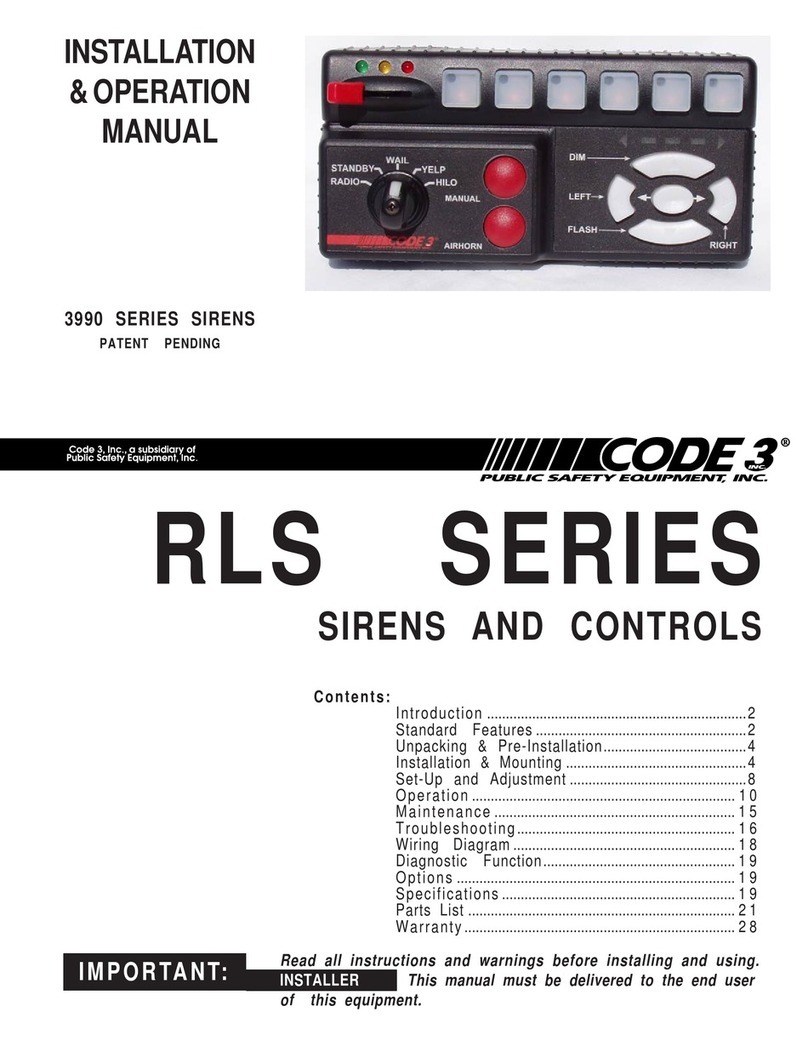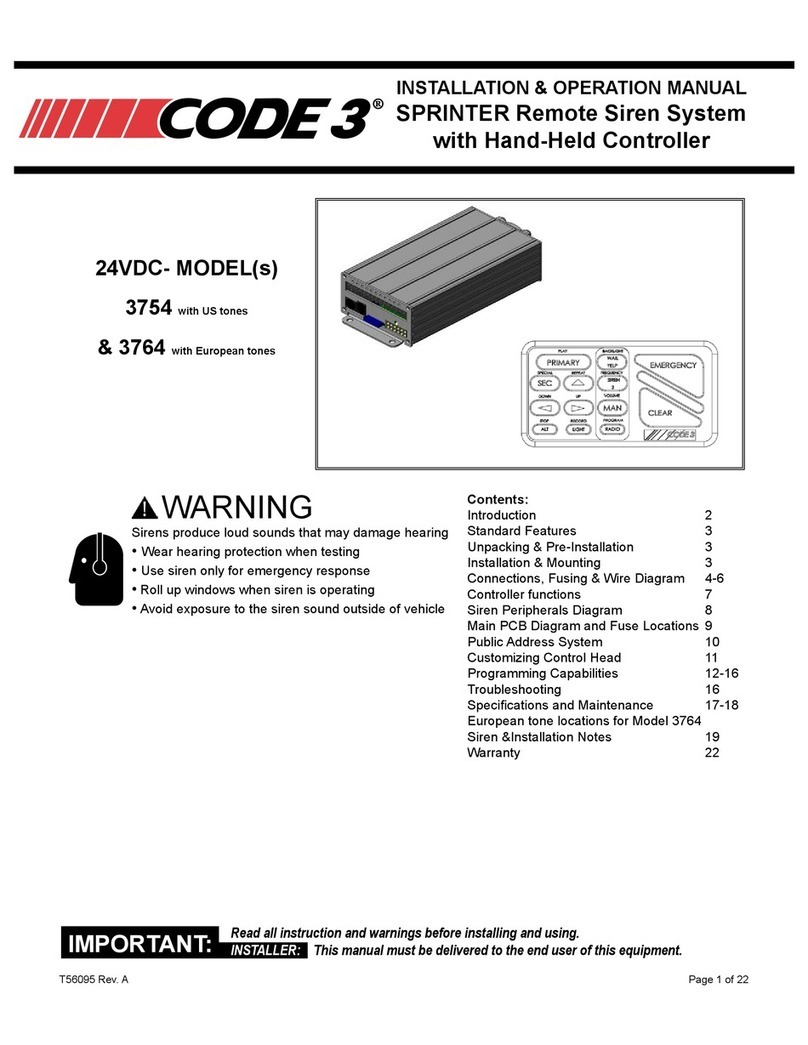
4
Auxiliary A-H Push-Buttons - As congured by the Siren Conguration Software, eight on/off Auxiliary push-buttons are readily accessible for
controlling the Auxiliary outputs of the Amplier. Each Auxiliary push-button can be custom labeled with the supplied label kit. Each push-button is
backlighted when activated to alert the operator. The default setting is for each Auxiliary push-button to control the corresponding Auxiliary output of
the Amplier. Auxiliary A through F supplies power to the load through the connector pins labeled A thru F. Auxiliary G and H supplies power with a
positive or ground voltage to the load through the connector pins labeled G and H.
3-Level Switch - The Control Head provides a 3-Level switch for changing the emergency warning mode. The 3-Level switch is located in the top left
corner of the control head. When the 3-Level switch is switched to the far left position, the unit is off. When the 3-Level switch is in the rst position
from the left, the level 1 conguration of the lights is turned on. When the 3-Level switch is in the second position from the left, the level 1 & 2 con-
guration of lights are turned on. When the 3-Level switch is in the third position from the left, the level 1, 2, & 3 conguration of the lights are turned
on. Level 1, 2, & 3 activate the LightAlert if supplied. These default settings can be altered using the Siren Conguration Software. The 3-Level
switch may be overridden by other push-buttons. If the push-buttons are programmed to a higher level than the position of the 3-Level switch, the
push-buttons will take precedence. If the push-buttons are programmed to a lower level than the position of the 3-Level switch, the 3-Level switch will
take precedence. The lighting can be set to various levels for the WAIL, YELP, ALT TONE, MANUAL, and AUX push-buttons. Visit these sections in
the conguration software to set these preferences.
3-Color Status LED - Three LEDs are visible on the front of the remote siren amplier. When the 3-Level switch is set to Level 1 the green LED
lights. When the siren is set to Level 2 both the green and yellow LEDs light. When the siren is set to Level 3 the green, yellow, and red LEDs light.
These LEDs indicate the level of the siren and controls. These Levels are congurable in the Siren Conguration Software User Manual.
Hands-Free - Hands-Free mode is directly linked to the Auxiliary push-buttons. By default, the Hands-Free mode is disabled. When an Auxiliary
push-button is congured for Hands-Free and that Auxiliary push-button has been turned on, the Hands-Free mode is active but waiting for an initial
press of the horn ring to activate the WAIL push-button. A second press of the horn ring will activate the YELP push-button. Pressing the horn ring a
third time will activate the ALT TONE push-button. A fourth press of the horn ring will return to the WAIL push-button. This type of scrolling will con-
tinue until the user deactivates the Hands-Free Scroll. Pressing the Auxiliary push-button turns off the sound and deactivates the Hands-Free Scroll.
Pressing and holding the horn ring will turn off the sound but leave Hands-Free Scroll in the active mode. The Remote input and Manual push-button
can also be congured for multiple functions during Hands-Free mode. Please refer to Z3 Siren Conguration Manual for details. See Table on page
6 for factory settings.
Horn Ring - The siren accepts either a positive or a ground signal into the Horn Ring input on the Amplier. The Horn Ring signal is disconnected
from the vehicle and connected to the Horn Ring input of the Amplier. The Horn Relay wire is then run from the Amplier to the horn of the vehicle.
This allows the Horn Ring to execute some of the user selectable functions of the Siren. The Horn Ring can be congured to multiple functions in
the Siren Active and Siren Inactive modes of operation. The Horn Ring is set to Scroll in the Hands-Free mode and cannot be changed. Please see
the Siren Conguration Software User’s Manual for details.
Horn Ring Transfer - The Horn Ring Transfer allows the Horn Ring to be disabled from the vehicle horn and the controls transferred to control other
siren tones. The Horn Ring Transfer can be set to occur at Level 1, Level 2, Level 3, or any combination of the three.
Remote - The siren accepts either a positive or a ground signal into the Remote Input wire on the Amplier. This Remote Input wire is usually con-
nected to a user supplied switch. The siren is factory set for a ground signal. The Remote input can be congured to multiple functions in the Siren
Active, Siren Inactive, and Hands-Free modes of operation. Please refer to the Siren Conguration Software User’s Manual for details. See Table
on page 6 for factory settings.
Hit-N-Go - Hit-N-Go only works when a siren tone is active. Once a siren tone is active, Hit-N-Go is activated simply by pressing the Horn Ring
(Vehicle Horn Control) or pressing the Remote input. It will go to the Override tone for 8 seconds and then return to the primary tone. The actual tone
for the Hit-N-Go depends on which push-button is active. If the WAIL push-button is active then the Hit-N-Go (Override) tone is the Yelp tone. If the
YELP push-button is active then the Hit-N-Go tone is the Hyper-Yelp 1 tone, and if the ALT TONE push-button is active then the Hit-N-Go tone is the
Hyper-Lo 1 tone. These Override tones are user congurable in the Conguration Software. The siren can also be congured so the MANUAL push-
button is Hit-N-Go activator.
Scroll - Scroll only works when a siren tone is active. Once a siren tone is active, Scroll is activated simply by pressing the Horn Ring (Vehicle Horn
Control) or pressing the Remote input. The Scroll Mode will cause the siren to cycle through the WAIL, YELP and ALT TONE push-buttons. For
example, if the WAIL push-button is active and the Horn Ring (congured to scroll) is pressed, the YELP push-button will become active. Another
press of the Horn Ring will activate the ALT TONE push-button. Another press of the Horn Ring will return to activate the original WAIL push-button.
The siren can also be congured so the MANUAL push-button activates the Scroll. NOTE: Pressing and holding the Horn Ring for more than a half
second will cause the Siren to generate the Air Horn tone.
Scroll On/Off - The Scroll On/Off mode works like the Scroll mode except the Siren will scroll the primary tones through an off state. The Siren
will scroll from Wail to Yelp to Alt Tone to off and then back to Wail. The Remote input can be congured to activate Scroll On/Off. NOTE: Pressing





























